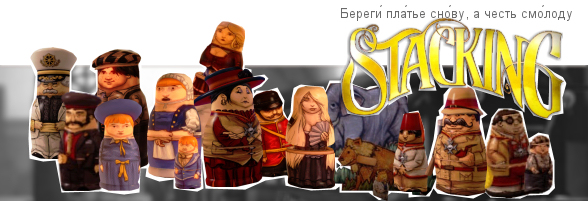Day of the Dead paper mache skeletons, and now matryoshka dolls. Maybe someone well educated on culturally indigenous figurines could predict the next breed we’ll see brought to life by a Schafer-assembled team?
Double Fine’s latest, Stacking, is a 3D puzzle game set during the industrial revolution in which you control the plucky but highly diminutive Charlie Blackmore, a Russian nesting doll like the sort you’ve probably played with at least once in your childhood. Charlie’s slightness of stature proves highly advantageous in his quest to rescue his indentured siblings from the despotic Baron, as it allows him to stack inside other characters, provided they are exactly one size bigger than himself or the doll he’s currently occupying.
This ability to stack and unstack is the principal gameplay mechanic of Stacking, which despite its deceptive (and addictive) simplicity proves fertile for puzzle possibilities. By jumping inside another doll, accomplished by pressing a button while standing behind the character to be violated, Charlie inherits an ability that more or less defines the host. (This theory would remark less poorly on the violinist than, say, the perpetual flatulator.) The abilities range from useful to just plain silly, and quite successfully both in the more inspired cases.
The game’s five levels, one of which is a train station hub and all of which are brimming with a motley crowd of dolls to try out or otherwise aggravate, are large, open environments where exploration is encouraged and rewarded. Perhaps the greatest achievement of Stacking is the way it almost completely removes any distinction between earnestly trying to pursue a goal and simply mucking around with the various dolls you encounter.
Progressing through the levels is a matter of completing challenges – example: ending caviar service on a cruise ship - the origins for which can always be traced by way of the wolf scent from The Legend of Zelda: Twilight Princess a handy feature available at the press of a button. Despite the freedom that characterizes the nonlinear locations, it never really seems possible to be lost except by one’s own volition. True enough of any Double Fine title, it’s not a world it’d be all that unfortunate to get lost in, even if it is one of pervasive child labor.
As you’ve learned from the screenshots, Stacking is a game whose visuals are hard not to fall in love with. “Charming” and “unique” are the types of words conventionally thrown, sometimes with an uncomfortable air of pity, at a game whose budget forces style to be more thoughtfully married to the technical parameters that set the bounds, but this game, with its inspired character design, lively and diorama-like environments, and silent movie aesthetic (ladled most thickly in the cutscenes), requires no favors in a description of its presentation. Along with Costume Quest, which I adored, Stacking’s project lead hails from the artistic side of the Double Fine family, so it comes as little surprise that its art direction is so striking. As with Grim Fandango, here is a game that is visually impressive because the very idea of animating the world it conceives was enough to justify doing so; in too many cases, a game plays like the artists were forced to make an interesting world in spite of its concept.
With Stacking, Double Fine has shared two of the four games hatched by its “amnesia fortnight” session during a late stage in Brutal Legend’s development cycle, and despite the frequency of the releases so far (especially in comparison to, say, the company’s first two products), it’s going to be a challenging wait for what’s next. If the studio’s embrace of a downloadable model is going to result in the kind of titles we’ve seen in Tasha Harris’ Costume Quest and Lee Petty’s Stacking, the possibility of it being a long-term strategy for the creative developers at Double Fine carries exactly zero downsides on the player’s end.
Jason once ripped open a person's body to try and get inside them and steal their special ability.

